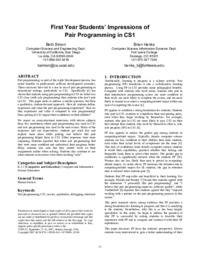First year students' impressions of pair programming in CS1 Publikationsdatum:
Zu finden in: ICER 2007 (Seite 73 bis 86), 2007
|
 |
 Diese Seite wurde seit 2 Jahren inhaltlich nicht mehr aktualisiert.
Unter Umständen ist sie nicht mehr aktuell.
Diese Seite wurde seit 2 Jahren inhaltlich nicht mehr aktualisiert.
Unter Umständen ist sie nicht mehr aktuell.
 Zusammenfassungen
Zusammenfassungen
Pair programming, as part of the Agile Development process, has noted benefits in professional software development scenarios. These successes have led to a rise in use of pair programming in educational settings, particularly in CS1. Specifically [6] has shown that students using pair programming in CS1 do better in a CS2 class (with solo programming) than students who don't pair in CS1. This paper seeks to address a similar question, but from a qualitative, student-focused approach. How do students define, experience and value the pair programming experience? How do they experience and value it compared to solo programming? Does pairing in CS1 impact their confidence in their abilities.
We report on semi-structured interviews with eleven subjects from two institutions where pair programming was used in CS1 and solo programming was used in the next course. Many of the responses met our expectations: students get stuck less and explore more ideas while pairing, and believe that pair programming helped them in CS1. Other responses were more surprising. Students reported that when solo programming that they were more confident and understood their programs better. Many students also said that they started work on their assignments earlier when soloing. Students also continue to use other students as resources even when working "solo".
 Dieses Konferenz-Paper erwähnt ...
Dieses Konferenz-Paper erwähnt ...
 Begriffe KB IB clear | Informatikcomputer science
, Informatik-Unterricht (Fachinformatik)Computer Science Education
,  pair programming
, pair programming
,  Programmieren Programmieren programming programming
|
 Dieses Konferenz-Paper erwähnt vermutlich nicht ...
Dieses Konferenz-Paper erwähnt vermutlich nicht ... 
 Nicht erwähnte Begriffe | Informatik-Didaktik, Informatikunterricht in der Schule |
 Tagcloud
Tagcloud
 Anderswo finden
Anderswo finden
 Volltext dieses Dokuments
Volltext dieses Dokuments
 |  First year students' impressions of pair programming in CS1: Fulltext at the ACM Digital Library ( First year students' impressions of pair programming in CS1: Fulltext at the ACM Digital Library ( : :  , 314 kByte; , 314 kByte;  : :  2020-11-28) 2020-11-28) |
 Anderswo suchen
Anderswo suchen 
 Beat und dieses Konferenz-Paper
Beat und dieses Konferenz-Paper
Beat hat Dieses Konferenz-Paper während seiner Zeit am Institut für Medien und Schule (IMS) ins Biblionetz aufgenommen. Beat besitzt kein physisches, aber ein digitales Exemplar. Eine digitale Version ist auf dem Internet verfügbar (s.o.). Aufgrund der wenigen Einträge im Biblionetz scheint er es nicht wirklich gelesen zu haben. Es gibt bisher auch nur wenige Objekte im Biblionetz, die dieses Werk zitieren.










 Biblionetz-History
Biblionetz-History